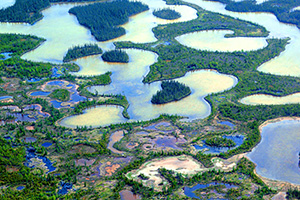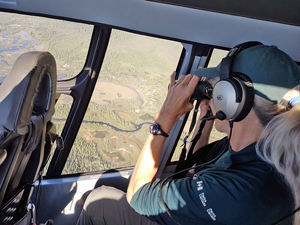
Photo: Klaus Nigge
Whooping Cranes
Wood Buffalo National Park
Why Endangered?
A Whooping Crane Mystery!
Back from the Brink of Extinction
Whooping crane conservation update, September 2021
Wood Buffalo National Park protects the nesting area of the last natural wild migratory flock of whooping cranes left in the world. The population of the Wood Buffalo – Aransas wild migratory flock has increased to an estimated 505 birds as of 2018. This is the highest count yet for this wild migratory flock since their near-extinction in the early 1940’s.
The International Whooping Crane Recovery Program – which involves Canada, the United States, and many partners – is dedicated to the recovery of this COSEWIC endangered species. In Canada, the lead organization for the program is the Canadian Wildlife Service, and in the United States it is the U.S. Fish & Wildlife Service. Parks Canada (Wood Buffalo National Park) also has a representative on the International Whooping Crane Recovery Team.

Photo: Parks Canada / John D McKinnon
In Wood Buffalo National Park, the whooping crane nesting area is a Ramsar site, or Wetland of International Significance. It is a maze of small shallow wetlands – inhospitable to humans - but a perfect remote habitat for the whooping cranes to nest and raise their young, and a key contributing factor to the recovery and ongoing conservation of this endangered species. The Wood Buffalo – Aransas flock migrates 4000 km twice yearly between Wood Buffalo National Park and their wintering area at the Aransas National Wildlife Refuge along the Gulf of Mexico in southern Texas.
Whooping Crane Monitoring
Wood Buffalo National Park and the Canadian Wildlife Service conduct monitoring surveys of the nesting area annually. They survey and count the number of nesting pairs after the birds have arrived in the spring, and in late summer they survey again to count the number of fledglings prior to their migration.

Photo: Parks Canada / John D McKinnon
The monitoring surveys are done by helicopter. Equipment includes a GPS unit, a computer, a camera, data sheets and binoculars. The birds’ behaviour is also observed and if they show any signs of agitation the observers pull back so as not to interfere with the nesting and raising of chicks.
Today we are learning even more thanks to sophisticated GPS and satellite tracking technology. Parks Canada is a supporting partner in the Whooping Crane Telemetry Project, a long-term study which started in 2010 and over time will provide even more in-depth information about the movements of the marked birds during migration, as well as within their nesting and wintering areas. Parks Canada staff have been part of the international team tasked with fitting selected adults and juveniles in the nesting area with GPS transmitters on leg bands as part of this study.
The Canadian Wildlife Service is also looking at the use of high resolution satellite imagery for monitoring of nests. This project is still in the very early stages.
For more information:
Rhona Kindopp
A/ Resource Conservation Manager
Wood Buffalo National Park
rhona.kindopp@pc.gc.ca
867-872-7932
- Date modified :